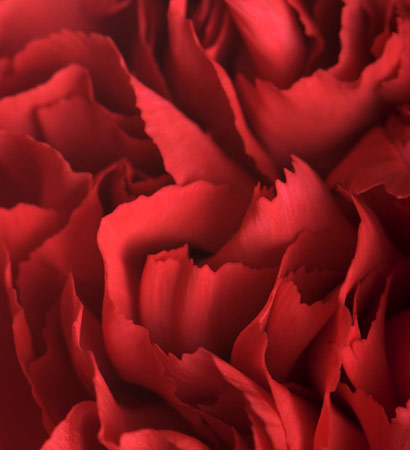National Symbols: National Flower
Red Carnation (common name)
Dianthus caryophyllus (scientific name)
Designation
Official
Classification
- Kingdom: Plantae
- Division: Magnoliophyta
- Class: Eudicots
- Order: Caryophyllales
- Family: Caryophyllaceae
- Genus: Dianthus
- Species: D. caryophyllus
The Flower
The species Dianthus caryophyllus includes smaller, old-fashioned clove pinks as well as the larger, modern cultivated carnations. These flowers are probably native to the Mediterranean region but the exact original range is unknown because of extensive cultivation during the last 2,000 years. Carnations start out in spring as a mound of grasslike bluish or grayish green leaves with a whitish sheen. Long, very slender, tough stalks grow up from the mounds. Buds form on the stalks and bloom in summer, usually July or August. The flowers have multiple petals with pinked or serrated edges. Stamens are interspersed with the petals and usually are not visible. Flowers normally last a week (or up to two weeks in good weather), and have a sweet, clove-like scent. Most gardeners choose to cut the stalks before the flowers form seeds, but when the bisexual flowers are pollinated—usually by butterflies—they form capsules containing numerous tiny seeds. The seeds ripen a month after the flowers bloom, from August to September. Carnations prefer full sun and good drainage, but can tolerate some shade in hotter climates.
Physical Details
Duration: Perennial
Plant: Thin, straight leaves with individual flowers on long stalks
Mature Height: 35-40 cm (14-16 in)
Flowering: July to August
Flowers: 5-9 cm (2–3.5 in) wide, multiple serrated petals
Flower Color: White, pink, red, yellow, purple
Leaves: 2.8-5 cm (1.5–2 in) long; narrow, grass-like
Fruit/Seed Color: Brown
Habitat
Location: Sunny, open areas or moderately shaded locations in hotter climates.
Range: Temperate regions worldwide.
Trivia
- These flowers are mentioned in Roman mythology and appear in the natural history records of the Roman writer, Pliny the Elder. Catholic monks probably began cultivating carnations in the late 13th century.
- Carnations are closely identified with Spain, and are the country's most popular cut flowers. Mediterranean Spain has an ideal climate for growing carnations, and the flowers are among the nation's important exports. They also are sometimes featured on Spanish postage stamps. Carnations are standard ornaments for female flamenco dancers.
Article written for World Trade Press by WTP Staff.
Copyright © 1993—2024 World Trade Press. All rights reserved.

 Spain
Spain 
